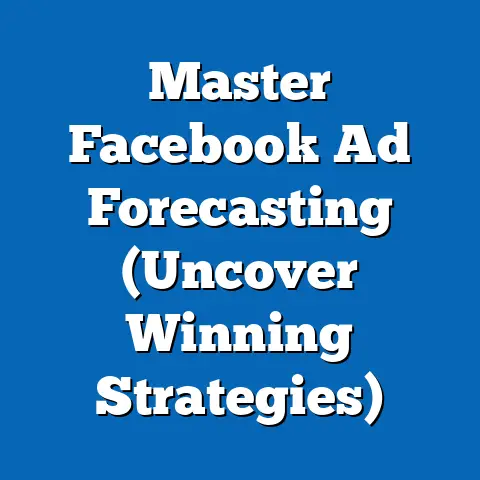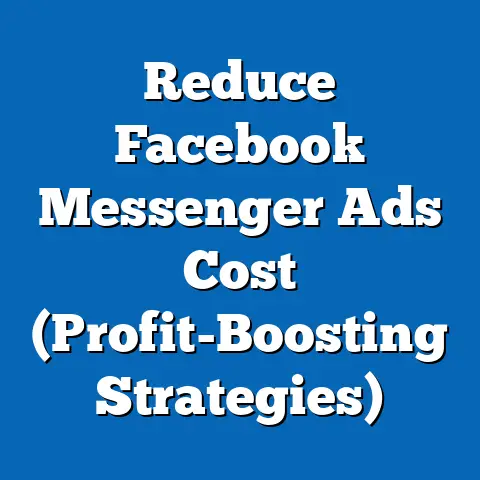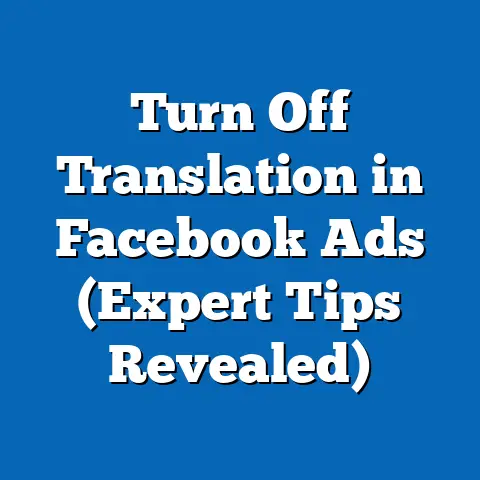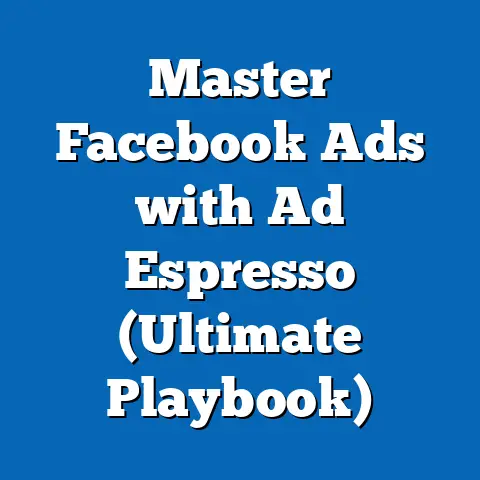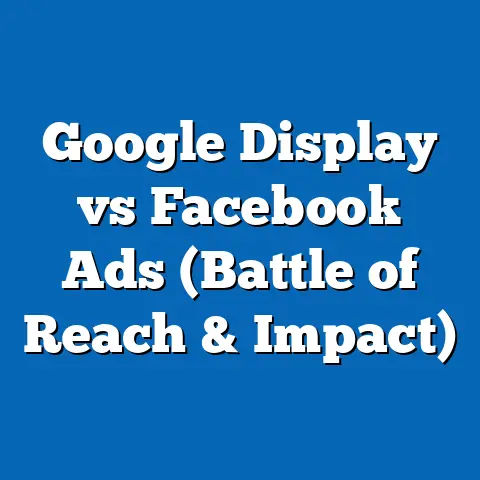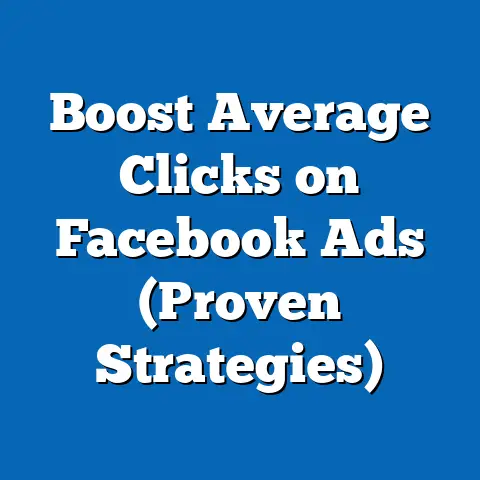Maximize Service Reach with Effective Facebook Ads (Pro Strategies)
It’s no secret that we live in a world increasingly focused on health and wellness. Everywhere I look, I see people prioritizing fitness, nutrition, and mental well-being. From organic grocery stores popping up on every corner to the explosion of fitness trackers and meditation apps, it’s clear that health is no longer a niche interest – it’s a mainstream priority. I remember when finding a yoga studio was like searching for a hidden gem; now, they’re as common as coffee shops!
And let’s be honest, in today’s digital landscape, that means Facebook Ads. I’ve personally seen countless health-related businesses transform their reach and impact using the platform’s powerful targeting capabilities. But throwing money at Facebook Ads without a solid strategy is like trying to build a house without a blueprint – you might end up with something, but it’s unlikely to be what you envisioned.
Get ready to unlock the potential of Facebook Ads and connect with the audience who needs your services most. Let’s dive in!
Understanding the Facebook Ads Landscape
Before you start crafting killer ad copy or diving into complex targeting options, it’s crucial to understand the lay of the land. Facebook Ads isn’t just a platform; it’s an ecosystem with its own rules, nuances, and best practices. Think of it as learning the local customs before traveling to a new country – it’ll save you a lot of headaches (and wasted ad spend) in the long run.
Overview of Facebook Ads
At its core, Facebook Ads is a pay-to-play system that allows you to display your message to a highly targeted audience within the Facebook and Instagram platforms (and the Meta Audience Network). It operates on an auction-based model, where advertisers bid against each other to show their ads to specific users. The higher your bid and the more relevant your ad, the more likely it is to be shown.
I’ve always found the sheer variety of ad formats available on Facebook to be one of its greatest strengths. Here’s a quick rundown of some of the most popular options:
- Image Ads: These are the simplest form of Facebook Ads, consisting of a single image, ad copy, and a call-to-action button. They’re great for showcasing a visually appealing service or product.
- Video Ads: Video is king in the digital world, and Facebook Ads are no exception. Video ads are incredibly engaging and can be used to tell a story, demonstrate a service, or share a testimonial.
- Carousel Ads: These ads allow you to showcase multiple images or videos in a single ad unit, each with its own headline, description, and link. They’re perfect for highlighting different aspects of your service or showcasing a range of products.
- Collection Ads: Designed primarily for mobile, collection ads feature a cover image or video followed by a selection of related products. They’re a great way to drive traffic to your online store or showcase a specific collection of services.
- Lead Ads: These ads are specifically designed to generate leads directly within the Facebook platform. They allow users to submit their contact information without ever leaving Facebook, making it incredibly easy to capture valuable leads.
- Instant Experience Ads: Formerly known as Canvas ads, Instant Experience ads are full-screen, mobile-optimized experiences that load instantly when someone clicks on your ad. They’re perfect for creating immersive brand experiences and showcasing your services in a visually compelling way.
Each ad format has its own strengths and weaknesses, and the best choice for your business will depend on your specific goals and target audience.
Target Audience Insights
I cannot stress enough how important it is to understand your target audience. It’s the foundation upon which all successful Facebook Ad campaigns are built. You can have the most beautifully designed ad in the world, but if it’s shown to the wrong people, it’s going to fall flat.
Think about it: who are you trying to reach with your health services? Are you targeting young athletes recovering from injuries? Busy professionals looking for stress management techniques? Seniors seeking preventative care? Each group will have different needs, interests, and online behaviors.
Facebook offers a wealth of data to help you understand your target audience, including:
- Demographics: Age, gender, location, education level, relationship status, job title, and more.
- Interests: Hobbies, passions, and topics they’re interested in, based on their Facebook activity.
- Behaviors: Purchase behaviors, device usage, travel habits, and other actions they take online and offline.
- Connections: People who are connected to your Facebook page, app, or events.
For health-related services, here are some key user statistics to consider:
- Age: Different age groups have different health concerns. For example, young adults might be interested in fitness and nutrition, while older adults might be more focused on chronic disease management.
- Location: Local services, like physiotherapy clinics or yoga studios, should focus on targeting users within a specific geographic area.
- Interests: Target users who are interested in health and wellness topics, such as fitness, nutrition, yoga, meditation, healthy eating, and specific health conditions.
- Behaviors: Target users who have purchased health-related products or services in the past, or who have visited health-related websites.
According to a recent study by Statista, over 60% of Facebook users are interested in health and wellness topics. This presents a huge opportunity for health-related businesses to connect with a highly engaged audience.
Algorithm Insights
Understanding how Facebook’s algorithm works is like understanding the rules of a game. The better you understand the rules, the better you can play the game and win. The algorithm, in simple terms, is a complex set of rules that determines which content is shown to which users. It prioritizes content that is deemed to be relevant, engaging, and valuable to each individual user.
Here’s how you can leverage the algorithm to your advantage:
- Create High-Quality Content: The algorithm favors content that is engaging and provides value to users. This means creating ads that are visually appealing, informative, and relevant to your target audience.
- Encourage Engagement: The more people engage with your ads (likes, comments, shares), the more likely the algorithm is to show your ads to more people. Encourage engagement by asking questions, running contests, or simply creating content that sparks conversation.
- Target the Right Audience: As I mentioned earlier, targeting the right audience is crucial for success. The more relevant your ads are to the users who see them, the more likely they are to engage with them.
- Use Facebook’s Ad Relevance Diagnostics: Facebook provides a tool called Ad Relevance Diagnostics that helps you understand how relevant your ads are to your target audience. This tool provides feedback on the quality of your ad, the relevance of your targeting, and the estimated engagement rate.
- Stay Up-to-Date: Facebook’s algorithm is constantly evolving, so it’s important to stay up-to-date on the latest changes and best practices. Follow industry blogs, attend webinars, and experiment with new features to stay ahead of the curve.
Key Takeaway: Understanding the Facebook Ads landscape is essential for success. By understanding the different ad formats, targeting options, and the algorithm, you can create more effective campaigns that reach the right audience and achieve your business goals.
Next Steps: Take some time to research your target audience and understand their needs, interests, and online behaviors. Experiment with different ad formats and targeting options to see what works best for your business. And always stay up-to-date on the latest changes to the Facebook Ads platform.
Crafting Compelling Ad Content
Now that you have a solid understanding of the Facebook Ads landscape, it’s time to focus on the heart of your campaigns: the ad content itself. No matter how precisely you target your audience, if your ads are boring, irrelevant, or poorly designed, they’re going to get ignored. Think of your ad as a first impression – you want to make it count!
Health-Focused Messaging
When it comes to health-focused messaging, authenticity and empathy are key. People are bombarded with marketing messages every day, so you need to cut through the noise by connecting with them on a personal level. Avoid overly salesy language or making unrealistic promises. Instead, focus on the benefits of your services and how they can help people improve their lives.
Here are some examples of compelling ad copy that resonates with health-conscious consumers:
- Highlight the Benefits: “Feeling stressed and overwhelmed? Our mindfulness workshops can help you find inner peace and improve your overall well-being.”
- Share Testimonials: “After struggling with chronic back pain for years, I finally found relief with [Your Service]. I highly recommend them!” – [Customer Name]”
- Unique Selling Proposition (USP): “Experience personalized physiotherapy tailored to your specific needs. Our expert therapists will create a treatment plan that helps you achieve your goals.”
- Address Pain Points: “Tired of fad diets that don’t work? Our registered dietitians will help you develop a sustainable and healthy eating plan that fits your lifestyle.”
- Offer a Solution: “Suffering from seasonal allergies? Our natural allergy relief treatments can help you breathe easy and enjoy the outdoors.”
I’ve found that using storytelling in your ad copy can be incredibly effective. Share a brief story about a client who benefited from your services, or talk about your own journey in the health and wellness field. People connect with stories on a deeper level than they do with facts and figures.
Visual Elements
Visuals are the first thing people see when they encounter your ad, so they need to be eye-catching and relevant. Choose images or videos that align with health themes and evoke emotions related to wellness and care. Avoid using stock photos that look generic or staged. Instead, opt for authentic images of real people using your services or experiencing positive results.
Here are some tips for choosing effective visuals:
- Use High-Quality Images: Make sure your images are clear, well-lit, and visually appealing. Avoid blurry or pixelated images.
- Showcase Your Services: Use images or videos that showcase your services in action. For example, a physiotherapy clinic could show a therapist working with a patient, or a yoga studio could show a group of people practicing yoga.
- Evoke Emotions: Choose visuals that evoke positive emotions, such as happiness, relaxation, or energy.
- Be Inclusive: Represent a diverse range of people in your visuals to appeal to a wider audience.
- Follow Facebook’s Ad Specs: Make sure your visuals meet Facebook’s ad specifications for image size, resolution, and aspect ratio.
I’ve personally seen a huge difference in ad performance when using authentic, high-quality visuals versus generic stock photos. People can tell the difference, and they’re more likely to engage with ads that feel real and relatable.
Call to Action (CTA)
Your call to action is the final piece of the puzzle. It’s the instruction that tells people what you want them to do after seeing your ad. A strong CTA is essential for driving conversions and achieving your campaign goals.
Here are some examples of effective CTAs for health services:
- Learn More: This is a great option for ads that are focused on raising awareness or providing information.
- Book Now: Use this CTA if you want people to schedule an appointment or register for a class.
- Get a Free Consultation: This is a great way to generate leads and encourage people to try your services.
- Download Now: Use this CTA if you’re offering a free ebook, guide, or other resource.
- Shop Now: Use this CTA if you’re selling health-related products online.
- Contact Us: This is a good option for ads that are focused on customer service or providing support.
I always recommend testing different CTAs to see which ones perform best for your target audience. You can use Facebook’s A/B testing feature to compare different versions of your ad and see which one drives the most conversions.
Key Takeaway: Compelling ad content is essential for capturing attention and driving conversions. By crafting health-focused messaging, using high-quality visuals, and including a strong call to action, you can create ads that resonate with your target audience and achieve your business goals.
Next Steps: Review your existing Facebook Ads and evaluate the quality of your ad copy, visuals, and CTAs. Experiment with different approaches to see what works best for your business. And always keep your target audience in mind when crafting your ad content.
Targeting Strategies for Health Services
With your compelling ad content ready to go, it’s time to focus on getting it in front of the right people. Effective targeting is the key to maximizing your reach and ensuring that your ads are seen by those most likely to be interested in your services. Facebook offers a wide range of targeting options, allowing you to reach specific demographics, interests, and behaviors.
Demographic Targeting
Demographic targeting allows you to reach specific age groups, genders, locations, education levels, and other demographic characteristics. This is a great way to narrow down your audience and ensure that your ads are seen by those who are most likely to be interested in your services.
For health services, here are some demographic targeting considerations:
- Age: Different age groups have different health concerns. For example, young adults might be interested in fitness and nutrition, while older adults might be more focused on chronic disease management.
- Gender: Some health conditions are more prevalent in certain genders. For example, women are more likely to experience osteoporosis, while men are more likely to experience heart disease.
- Location: Local services, like physiotherapy clinics or yoga studios, should focus on targeting users within a specific geographic area.
- Education Level: People with higher education levels tend to be more health-conscious and proactive about their health.
I’ve found that combining demographic targeting with other targeting options, such as interest-based targeting and behavioral targeting, can be particularly effective.
Behavioral Targeting
Behavioral targeting allows you to reach users based on their online behaviors, such as their purchase history, device usage, travel habits, and other actions they take online and offline. This is a great way to target users who have shown an interest in health and wellness topics in the past.
Here are some behavioral targeting options that are relevant to health services:
- Fitness Enthusiasts: Target users who have shown an interest in fitness-related activities, such as running, cycling, swimming, or weightlifting.
- Health-Conscious Eaters: Target users who have shown an interest in healthy eating, organic food, or vegetarian/vegan diets.
- Individuals Seeking Specific Health Services: Target users who have searched for specific health services online, such as physiotherapy, chiropractic care, or acupuncture.
- People Who Have Purchased Health-Related Products: Target users who have purchased health-related products online, such as vitamins, supplements, or fitness equipment.
I’ve personally used behavioral targeting to reach a highly targeted audience of potential clients for a wellness retreat. By targeting users who had previously purchased yoga mats and meditation apps, I was able to generate a high number of qualified leads.
Custom Audiences
Custom audiences allow you to target your existing customers or website visitors with Facebook Ads. This is a great way to re-engage with people who are already familiar with your brand and encourage them to take action.
Here are some ways to create custom audiences:
- Customer List: Upload a list of your existing customers’ email addresses or phone numbers to create a custom audience.
- Website Traffic: Install the Facebook Pixel on your website to track the behavior of your visitors and create custom audiences based on their actions.
- App Activity: Track the activity of your app users and create custom audiences based on their in-app behavior.
- Engagement: Create custom audiences based on people who have engaged with your Facebook page, ads, or events.
Once you’ve created a custom audience, you can use it to target your ads directly to those people, or you can use it to create a lookalike audience.
Lookalike Audiences
Lookalike audiences allow you to reach new people who are similar to your existing customers or website visitors. This is a great way to expand your reach and find new potential clients who are likely to be interested in your services.
Facebook uses its vast database of user information to identify people who share similar characteristics with your custom audience. You can specify the size of your lookalike audience, ranging from 1% (most similar) to 10% (broadest reach).
I’ve found that lookalike audiences can be incredibly effective for generating new leads and driving conversions. By targeting people who are similar to my best customers, I’ve been able to significantly improve the ROI of my Facebook Ad campaigns.
Key Takeaway: Effective targeting is essential for maximizing your reach and ensuring that your ads are seen by those most likely to be interested in your services. By using demographic targeting, behavioral targeting, custom audiences, and lookalike audiences, you can reach a highly targeted audience and achieve your business goals.
Next Steps: Analyze your existing customer data to identify key characteristics and behaviors. Create custom audiences based on your customer list and website traffic. Experiment with lookalike audiences to expand your reach and find new potential clients.
Budgeting and Bidding Strategies
Now that you’ve crafted compelling ad content and identified your target audience, it’s time to talk about money. Understanding how to budget and bid effectively is crucial for maximizing your ROI and ensuring that you’re not wasting money on ineffective ads.
Understanding Costs
Facebook Ads operates on an auction-based model, where advertisers bid against each other to show their ads to specific users. The cost of your ads will depend on a variety of factors, including:
- Target Audience: Highly competitive target audiences will typically cost more to reach.
- Ad Relevance: The more relevant your ads are to your target audience, the lower your costs will be.
- Ad Quality: High-quality ads with engaging visuals and compelling copy will typically cost less than low-quality ads.
- Bidding Strategy: Your bidding strategy will also affect your costs.
- Placement: Where your ad is placed (Facebook feed, Instagram feed, Audience Network) can also affect cost.
Here are some common cost metrics to be aware of:
- Cost Per Click (CPC): The amount you pay each time someone clicks on your ad.
- Cost Per Mille (CPM): The amount you pay for every 1,000 impressions (times your ad is shown).
- Cost Per Acquisition (CPA): The amount you pay for each conversion (e.g., lead, sale, appointment).
I’ve found that the average CPC for health-related services on Facebook is around \$1-\$3, while the average CPM is around \$5-\$10. However, these numbers can vary widely depending on the factors mentioned above.
Budgeting Tips
Here are some tips for allocating your budget effectively:
- Start Small: If you’re new to Facebook Ads, start with a small budget and gradually increase it as you learn what works best.
- Set a Daily or Lifetime Budget: You can set a daily budget, which is the average amount you’re willing to spend each day, or a lifetime budget, which is the total amount you’re willing to spend over the entire duration of your campaign.
- Consider Campaign Objectives: Allocate more budget to campaigns that are aligned with your primary business goals, such as generating leads or driving sales.
- Monitor Performance: Regularly monitor the performance of your ads and adjust your budget accordingly. If an ad is performing well, consider increasing its budget. If an ad is performing poorly, consider pausing it or reducing its budget.
- Use Budget Pacing: Facebook’s budget pacing feature helps you spend your budget evenly over the duration of your campaign. This can help prevent you from overspending your budget early on.
I always recommend starting with a daily budget of around \$10-\$20 per ad set and then adjusting it based on performance.
Bidding Strategies
Facebook offers a variety of bidding strategies to help you achieve your campaign goals. Here are some of the most common options:
- Highest Volume (Automated Bidding): Facebook automatically sets your bids to get you the most results for your budget. This is a good option for beginners or for campaigns where you’re not sure what to bid.
- Cost Per Result Goal: Facebook will try to get you the most results while staying within your target cost per result.
- Manual Bidding: You set your bids manually, giving you more control over your costs. This is a good option for experienced advertisers who want to optimize their bids for maximum ROI.
I’ve found that automatic bidding is a good starting point for most campaigns. However, as you gain more experience, you may want to experiment with manual bidding to optimize your costs.
Key Takeaway: Understanding how to budget and bid effectively is crucial for maximizing your ROI on Facebook Ads. By understanding the costs, setting a realistic budget, and choosing the right bidding strategy, you can ensure that you’re not wasting money on ineffective ads.
Next Steps: Determine your budget for Facebook Ads based on your business goals and resources. Experiment with different bidding strategies to see what works best for your target audience and campaign objectives. Regularly monitor the performance of your ads and adjust your budget and bidding strategies accordingly.
Analyzing and Optimizing Ad Performance
Launching your Facebook Ad campaigns is just the beginning. The real magic happens when you start analyzing your results and optimizing your campaigns for maximum performance. Think of it as fine-tuning a musical instrument – you need to tweak and adjust until you get the perfect sound.
Key Performance Indicators (KPIs)
Key Performance Indicators (KPIs) are the metrics that you use to measure the success of your Facebook Ad campaigns. It’s important to identify the KPIs that are most relevant to your business goals and track them regularly.
Here are some essential KPIs for health service ads:
- Engagement Rate: The percentage of people who saw your ad and engaged with it (likes, comments, shares). A high engagement rate indicates that your ad is resonating with your target audience.
- Click-Through Rate (CTR): The percentage of people who saw your ad and clicked on it. A high CTR indicates that your ad is relevant and appealing to your target audience.
- Conversion Rate: The percentage of people who clicked on your ad and completed a desired action (e.g., lead submission, appointment booking, purchase). A high conversion rate indicates that your ad is effectively driving conversions.
- Cost Per Acquisition (CPA): The amount you pay for each conversion. A low CPA indicates that your ad is cost-effective.
- Return on Ad Spend (ROAS): The amount of revenue you generate for every dollar you spend on ads. A high ROAS indicates that your ad is generating a good return on investment.
I always recommend tracking these KPIs on a daily or weekly basis to identify trends and areas for improvement.
Using Facebook Analytics
Facebook provides a wealth of data and analytics tools to help you understand the performance of your ads. Here are some of the most useful tools:
- Facebook Insights: Provides insights into your audience demographics, interests, and behaviors.
- Ads Manager: Allows you to track the performance of your ad campaigns in real-time, including impressions, clicks, conversions, and costs.
- A/B Testing: Allows you to test different versions of your ad (copy, visuals, targeting) to see which one performs best.
I’ve found that A/B testing is one of the most effective ways to optimize my Facebook Ad campaigns. By testing different versions of my ads, I can identify the elements that are most effective at driving engagement and conversions.
Here are some elements you can A/B test:
- Headline: Test different headlines to see which one captures the most attention.
- Ad Copy: Test different ad copy to see which one resonates most with your target audience.
- Visuals: Test different images or videos to see which one is most visually appealing.
- Call to Action: Test different calls to action to see which one drives the most conversions.
- Targeting: Test different targeting options to see which one reaches the most qualified audience.
Iterating on Success
Once you’ve identified the elements that are working well, it’s important to iterate on your success and scale your campaigns. This means increasing your budget, expanding your targeting, and creating new ads that are based on your winning formulas.
Here’s a framework for iterating on successful ads:
- Analyze Your Data: Review your Facebook Analytics to identify your best-performing ads and target audiences.
- Identify Key Elements: Identify the key elements that are contributing to the success of your ads (e.g., compelling headline, engaging visual, targeted audience).
- Create Variations: Create new ads that are based on your winning formulas, but with slight variations. For example, you could test different headlines, visuals, or calls to action.
- A/B Test Your Variations: Use Facebook’s A/B testing feature to compare your new ads to your existing ads.
- Scale Your Campaigns: If your new ads perform well, increase their budget and expand their targeting.
Key Takeaway: Analyzing and optimizing your ad performance is crucial for maximizing your ROI on Facebook Ads. By tracking your KPIs, using Facebook Analytics, and iterating on your success, you can continuously improve the performance of your campaigns.
Next Steps: Set up tracking for your key performance indicators. Regularly monitor the performance of your ads and identify areas for improvement. Use Facebook’s A/B testing feature to test different elements of your ads. Iterate on your success and scale your campaigns.
Conclusion
We’ve covered a lot of ground in this guide, from understanding the Facebook Ads landscape to crafting compelling ad content, targeting the right audience, budgeting effectively, and analyzing and optimizing your performance. These pro strategies are the key to unlocking the full potential of Facebook Ads for your health-related services.
Remember, the key takeaways are:
- Understand your target audience: Know their needs, interests, and online behaviors.
- Craft compelling ad content: Use authentic messaging, high-quality visuals, and a strong call to action.
- Target effectively: Use demographic targeting, behavioral targeting, custom audiences, and lookalike audiences to reach the right people.
- Budget strategically: Set a realistic budget and choose the right bidding strategy.
- Analyze and optimize: Track your KPIs, use Facebook Analytics, and iterate on your success.
I encourage you to implement these strategies in your own Facebook Ad campaigns and see the tangible improvements in your reach, engagement, and conversions. By effectively advertising your health services on Facebook, you can connect with the audience who needs your help most and make a positive impact on their lives.
Now, go out there and create some amazing Facebook Ads! Your potential clients are waiting to discover the benefits you offer. Don’t hesitate to experiment, learn, and adapt. The world of Facebook Ads is constantly evolving, but with the right knowledge and a proactive approach, you can stay ahead of the curve and achieve your business goals.

